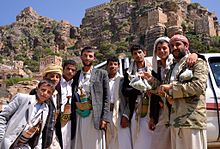This article may require copy editing for grammar. (February 2024) |
 Yemeni Tribesmen | |
| Languages | |
|---|---|
| Arabic (Yemeni) | |
| Religion | |
| Shafi'i Islam, Zaydism |
The Tribes of Yemen are the tribes residing within the borders of the Republic of Yemen. There are no official statistics, but some studies indicate that tribes constitute about 85% of the population of 25,408,288 as of February 2013.[1][2] According to some statistics, there are approximately 200 tribes in Yemen, and some counted more than 400 tribes.[3][4] Yemen stands out as the most tribal nation in the Arab world due to the significant influence wielded by tribal leaders and their deep integration into the various facets of the state.[5]
Many tribes in Yemen have long histories, with some tracing their roots back to the era of the Kingdom of Sheba. Throughout history, these tribes have often formed alliances, either to establish or dismantle states. Despite their diverse origins, they often share common ancestry. In Yemen the lineage of the tribe is not as important as alliances.[6] Tribes are far from being homogeneous societal structures in any way. Several clans may share a common history and "lineage," but the tribe in Yemen is not a cohesive political entity. Clans belonging to a common "lineage" may change their affiliations and loyalties as dictated by needs and circumstances.[7] They and the allied tribe find a common “lineage.”[8]
Over long periods of time, Yemen remained a unified nation despite the lack of a central government that imposed its authority over the entire territory of Yemen, with the exception of short periods of Yemen's history. The nation was made up of a number of tribes, and the tribal division in Yemen stabilized with the advent of Islam into four federations. The tribes are: Himyar, Madhhaj, Kinda, and Hamdan.[9] The Madhhaj tribe group consists of three tribes: Ans, Murad, and Al-Hadda, and they live in the eastern regions of Yemen. As for the Himyar tribes, they inhabited the southern mountainous regions and the central plateaus, while Hamadan consists of Hashid and Bakil.[10] The political and economic conditions in Yemen during the Middle Ages and the early modern era led to the redrawing of the tribal map of Yemen. The Madhaj tribes joined the Bakil tribal confederation, and some Himyar tribes joined the Hashid tribal confederation.[11]
- ^ "Tribal Resistance and al-Qaeda: Suspected U.S. Airstrike Ignites Tribes in Yemen's Ma'rib Governorate. the James town foundation last retrieved DEC 72012". Archived from the original on 16 March 2020.
- ^ CIA World Factbook, Yemen Archived 2018-01-29 at the Wayback Machine
- ^ "Zaydi Islam". www.globalsecurity.org. Retrieved 19 February 2024.
- ^ الجزيرة نت Archived 19 March 2014 at the Wayback Machine
- ^ J. E. Peterson, Tribes and Politics in Yemen p.1
- ^ J. E. Peterson, Tribes and Politics in Yemen p.2
- ^ "Tribal Resistance and al-Qaeda: Suspected U.S. Airstrike Ignites Tribes in Yemen's Ma'rib Governorate. the James town foundation last retrieved DEC 72012". Archived from the original on 16 March 2020.
- ^ جواد علي المفصل ج 4 ص 420
- ^ حمزة علي لقمان، تاريخ القبائل اليمنية، دار الكلمة، صنعاء، 1985
- ^ محمد محسن الظاهري، القبيلة والتعددية السياسية في اليمن، رسالة دكتوراة
- ^ عبد الله عبد الكريم الجرافي، المقتطف من تاريخ اليمن، منشورات العصر الحديث، بيرون، طبعة2، 1987
